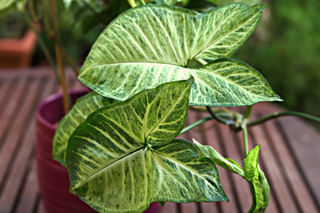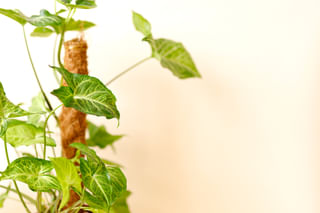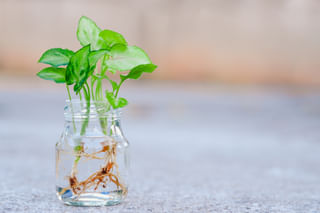How to care for the Arrowhead Plant (Syngonium podophyllum)
In this plant care guide, we're going to learn how to take care of an Arrowhead Plant (Syngonium podophyllum). It's a fantastic plant for beginners as it's easy to take care of and requires minimal maintenance. Let's learn how to help it thrive in your home!
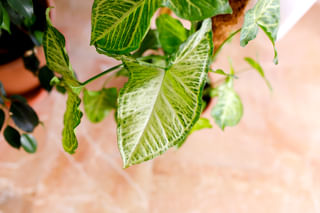
The Syngonium podophyllum has several common names you might have heard of before, including Arrowhead Plant, Arrowhead vine, Nephthytis, Arrowhead philodendron, and even African and American Evergreen. This plant sure has a lot of common names!
This Syngonium grows quickly, so you'll never have to be the impatient plant owner that just wants to see their plant grow.
I have been taking care of these plants for several years now and am here to share my knowledge with you so that it's easy for anyone to understand how to properly take care of these plants.
In this plant care guide, we're going to look at these topics related to taking care of this Syngonium podophyllum:
Ready to learn how to care for your Arrowhead Plant (Syngonium podophyllum) and make it thrive? Let's get started!
How often should you water the Arrowhead Plant (Syngonium podophyllum)?
Watering your Syngonium podophyllum is key to keeping it healthy and happy. It's best to water it around once a week, depending on the time of year and the climate in which you live. The soil should be damp but not soggy. During the summer months, you may need to water more often and during the winter you may need to water less.
Before you water your plant, it's important to check whether the top 2.5 cm (1 inch) has dried out. If the top of the soil is still moist, it's not time to water your plant yet. Allow the top of the soil to dry out before you water your Syngonium, as this will help you to avoid overwatering your plant.
You may be wondering how much water you should give your Syngonium at a time. To help you to give your Syngonium the right amount of water, I always recommend you use a pot with a drainage hole to grow your plant. Here's why: The drainage hole in the pot does 2 things: drain excess moisture and tell you when the soil has absorbed all the moisture it can.
The drainage hole tells you exactly when you've watered your plant enough because as soon as the excess moisture starts to drip out of the drainage hole, you've watered your plant enough. I recommend that you let the pot with the drainage hole drip any excess moisture for 5-10 minutes after you've watered your plant to make sure there is no excess moisture left in the pot.
What are the signs of overwatering for the Arrowhead Plant (Syngonium podophyllum)?
One of the most common signs of overwatering in the Arrowhead Plant (Syngonium podophyllum) is wilting leaves and stems. The plant may also start to yellow or even turn brown around the edges or tips, indicating that it has been given too much water.
Overwatered plants can also develop root rot, which is easy to spot. The soil will start to smell funky and the roots become brown/black and mushy.
If you notice any of these signs, reduce your watering frequency and make sure to drain any excess water from the pot immediately.
What are the signs of underwatering for the Arrowhead Plant (Syngonium podophyllum)?
The signs of underwatering for the Syngonium podophyllum include droopy leaves, wilting stems, and discoloration. The plant's leaves may start to yellow or curl inward and the stems may bend or droop as they become thinner. The soil will feel dry and dusty.
When you water after your plant has been too dry for too long, don't water a lot extra to compensate for being dry for too long. Water like you normally would, letting the soil soak up the moisture it can hold and letting the rest drain out of the drainage hole. The plant's roots will be sensitive to overwatering after being dry for too long, so it's important to not flood them with too much moisture.
What are the sunlight requirements for the Arrowhead Plant (Syngonium podophyllum)?
After watering, sunlight exposure is the most important thing to get right when taking care of a Syngonium podophyllum. The Syngonium podophyllum prefers bright, indirect sunlight. It should not receive direct sunlight (especially during the summer), as this can cause damage to the leaves and the stems of the plant.
What are the signs of too much sunlight for the Arrowhead Plant (Syngonium podophyllum)?
The signs of too much sunlight for the Arrowhead Plant (Syngonium podophyllum) are sunburned leaves and stems. The leaves may start to yellow or even turn brown around the edges or tips and the stems may become discolored or brittle.
What are the signs of too little sunlight for the Arrowhead Plant (Syngonium podophyllum)?
Besides not exposing your plant to too much sunlight, you should also make sure to not put it in a spot that doesn't have enough sunlight. If your Syngonium doesn't get enough sunlight, it'll show signs including slowed or stopped growth, as well as pale or yellowing leaves.
The plant may become leggy and thin as it reaches for the light. Leaves may start to drop off, and the stems turn weak and thin over time. To prevent this, make sure that your Syngonium is in a spot with bright, indirect light for most of the day.
Where should I place the Arrowhead Plant (Syngonium podophyllum) in my house?
Your Syngonium podophyllum likes bright, indirect light. This means that it will do best in a spot where it gets plenty of natural light, but is not in full sun during the late morning and early afternoon (especially during the summer).
Direct sunlight in the early morning and late afternoon is perfectly find though, even in the summer, as this sunlight isn't as harsh as the strong afternoon sun.
If you don't have any places that fit your Syngonium, you can also use grow lights to give your plants some extra light in a darker spot in your house.
What is the best soil for my Arrowhead Plant (Syngonium podophyllum)?
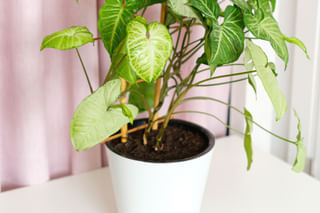
If you prefer to mix this potting soil yourself, you'll need equal parts of perlite or pumice, peat moss, and general potting soil. This mix will stay moist for a few days, but also stay light and airy for a long time and drain excess water to the bottom of the pot quite easily.
How often should I repot my Arrowhead Plant (Syngonium podophyllum)?
The Arrowhead Plant (Syngonium podophyllum) should be repotted every 1-2 years or whenever it becomes rootbound in its current pot. Besides giving your plant extra room to grow, repotting your Syngonium in fresh soil also helps it to get the nutrients it needs to stay healthy.
When your Syngonium podophyllum needs to be repotted in a larger pot, there are several signs your plant will display to tell you it's time. Firstly, if the soil feels dry and is difficult to moisten even after watering, this may be a sign that the plant has outgrown its pot.
Secondly, if you notice roots coming out of the pot's drainage holes, this is also a sign that your plant needs to be repotted. If you notice any of these signs, it's time to repot your plant!
When you're repotting your Syngonium, make sure to choose a pot that's one size larger than the current pot. This new pot is usually 2-5 cm (1-2 inches) larger on each side. This new pot gives your plant plenty of space to grow for a while, but won't put it at risk of accidentally overwatering it.
A pot that's too large for your plant contains a lot of extra soil that holds moisture. A plant that's too small can't absorb this moisture quickly enough, so your plant is always growing in soggy soil. This can lead to root rot quite easily, so the size of the pot is important.
Now that we've looked at the most important parts of taking care of a Syngonium, we can have a look at those parts of taking care of your plant that can make it a little more comfortable in its growing environment. Let's start with the temperature.
What is the ideal temperature range for the Arrowhead Plant (Syngonium podophyllum)?
The ideal temperature range for the Arrowhead Plant (Syngonium podophyllum) is between 15-27℃ (60 - 80℉). This temperature range is likely very similar to the temperature in your house right now, so you won't have to take any special steps to help your plant.
The Syngonium thrives in warm temperatures, but extreme heat can be damaging. If the temperature rises above 30℃ (86℉), the plant will start to suffer, because it'll dry out too quickly. On the other hand, if temperatures drop below 10℃ (50℉) for an extended period, the plant may suffer from cold damage.
It's also important to be aware of sudden temperature changes. Sudden shifts in temperature can cause shock and damage the plant, especially when the temperature change is very big. To avoid this, make sure to keep your Arrowhead Plant away from drafty windows and doors, and avoid placing it in direct sunlight during summer afternoons.
How much humidity does the Arrowhead Plant (Syngonium podophyllum) need?
The Syngonium podophyllum is a houseplant that likes high humidity levels in its growing environment but also doesn't mind if the humidity levels are a little lower (40-50%). Ideally, you should provide a humidity level of over 60% for the Syngonium to be a happy plant.
You don't have to place increase the humidity levels if they're around 40-50%, but if you want to you can raise the humidity by misting your plant or using a humidifier near your plant. Another great way to raise the humidity is to place several plants together and let them create their own microclimate.
You can find more tips on raising the humidity in your house by looking at 10 ways to raise the humidity in your house.
How often should you fertilize the Arrowhead Plant (Syngonium podophyllum)?
The Syngonium podophyllum is a fast-growing plant, so you'll need to fertilize it frequently to keep it healthy. I recommend that you fertilize your Syngonium once every 2-4 weeks during the spring and summer with a liquid fertilizer. During the fall and winter, you shouldn't fertilize your Syngonium at all, because it'll be in its dormancy period and won't use any of the fertilizers.
It's important not to overfertilize the Arrowhead Plant since this can cause foliar burn, which will damage the leaves and possibly kill the plant. This is why it's important to not fertilize your plant during the fall and winter.
When fertilizing the Arrowhead Plant, be sure to only apply fertilizer when the soil is already moist. Fertilizers should never be applied to dry soil as this could burn the roots of the plant and cause damage over time. Also, make sure not to place any fertilizer directly onto the leaves as this can also lead to leaf burn.
The best way to apply fertilizer is to apply it directly to the soil after you've lightly moistened the soil. After fertilizing, water your plant thoroughly to let the nutrients spread toward your plant's roots. If you're using a liquid fertilizer, you can simply add it to the water and water your plant like normal.
What is the best fertilizer for my Arrowhead Plant (Syngonium podophyllum)?
The best fertilizer for a Syngonium podophyllum is a balanced liquid fertilizer with equal parts nitrogen, phosphorus, and potassium (10-10-10). It is important to dilute the fertilizer according to the instructions on the label before applying it. An organic-based fertilizer or slow-release blend can also provide excellent results.
How often should I prune my Arrowhead Plant (Syngonium podophyllum)?
Pruning your plant is often quite a scary experience for beginning plant owners. You might be wondering if it's harming the plant or if it hurts. But no worries, pruning your plant promotes growth, lets you control the size of your plant, and makes it look better.
The Syngonium podophyllum is a vining plant, so you might want to regularly trim the stem to prevent them from becoming too long. Pruning is also important to do when you see dead stems or leaves. Dead foliage is a feast for pests, so you should make sure to trim these off as soon as they appear.
To prune your Syngonium, simply remove old and damaged leaves with a pair of sharp scissors. Make sure to cut back the stems to just above the node (the spot where a leaf grows out of the stem), as this will encourage new growth on that stem.
Unless you absolutely have to, you should only prune your plant during the spring and summer, so your plant has the chance to recover. During the fall and winter, your Syngonium won't grow (very quickly), so recovery takes longer and is riskier. During the spring and summer, the plant will recover quickly and put out new growth within weeks.
How do I propagate my Arrowhead Plant (Syngonium podophyllum)?
When you prune healthy stems off your Sygnonium, you have an opportunity to propagate these cuttings. In my experience, a Syngonium is one of the easiest plants to propagate. They grow and recover quickly, so the stem cuttings are easy to propagate. The most common method for propagation is to take a stem cutting and root it in water or soil.
To propagate in water, take a cutting from the stem at a node. Remove any lower leaves and place the stem in a jar or glass of water. Change the water every few days to keep it fresh and make sure to provide bright, indirect light. The cutting should root within a few weeks. After the roots have developed, you can plant them in soil and you'll have a new plant.
For propagating in soil, place the stem cuttings in a pot of moist soil. Keep the soil damp but not overly wet, and provide bright indirect light for best results. The cuttings should form roots within a few weeks and be ready to transplant once they have established themselves in the potting mix.
What are common pests for the Arrowhead Plant (Syngonium podophyllum)?
Common pests of an Arrowhead Plant (Syngonium podophyllum) include mealybugs, aphids, spider mites, and scale insects. Mealybugs can be identified by their white, cottony-looking egg sacks and are often found on the underside of leaves. Aphids are tiny pear-shaped insects that often colonize the stem and leaves of the plant. Spider mites can be identified by their webs and will cause yellowing or discoloration of the leaves. Scale insects look like tiny brown bumps on stems and leaves and can weaken a plant if left untreated.
If you notice any of these pests, it is best to treat them as soon as possible to prevent further damage. You can use things like insecticidal soap or neem oil, which you can find in most garden stores. It is also important to inspect your plant frequently and act quickly if you spot any pests.
Is the Arrowhead Plant (Syngonium podophyllum) toxic for cats and dogs?
The Syngonium podophyllum contains sticky white sap, which is poisonous to cats and dogs. If your pet ingests any part of the plant, it can cause oral irritation, intense burning, and swelling of the mouth, tongue, and lips.
Besides being toxic to your pets, it's also toxic for humans, so make sure to keep this plant out of reach of any curious children as well as your pets.
If you notice your pets or children have chewed on this Syngonium, make sure to call your veterinarian or local doctor as soon as possible to ask for advice.
Thank you for reading this post! I hope it helps you to keep your plants healthy and beautiful! If you're looking for more guides on specific plants, you can always request a plant guide to get a guide for the plant you have trouble with.
Test your plant care knowledge
Quiz completed!
Want to learn more? Sign up for my newsletter to receive free tips in your inbox!
Sign up now!